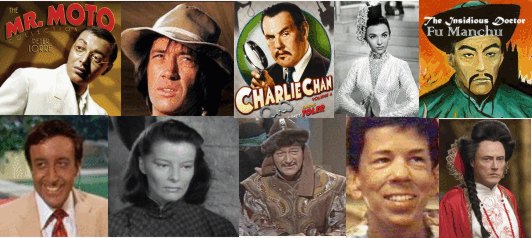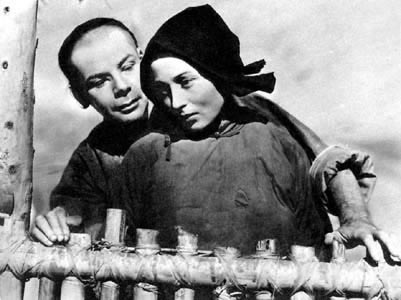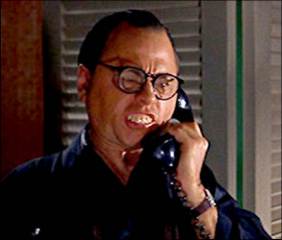Yellowface!
Yellowface in Film and TV

Whites in Yellowface have a long history on screen, beginning with Mary Pickford's Cio-Cio San in
Madame Butterfly (1915).
There were well-known Oriental actors at this time; in 1910, Lee Tung
Foo was already known as "the most remarkable China man in the United
States"ť due to his performances in vaudeville. Japanese American Sessue Hayakawa's roles in the silent films The Wrath of the Gods (1914) and The Typhoon (1914) transformed Hayakawa into an overnight success. The first Asian-American star of the American screen was born, and during the 1920s he was as famous as actors Charlie Chaplin and Douglas
Fairbanks. He was one of the highest paid stars of his time; making $5,000 a week in 1915 for The Cheat, and $2 million a year via his own production company during the
1920s. Hayakawa was the romantic idol of millions of American women
and in many ways, he was a precursor to Rudolph Valentino. When Hayakawa's contract with Paramount expired in May, 1918, the studio wanted him to star in The Sheik, but Hayakawa turned them down in
favor of starting his own company. The role went to Valentino who rose to overnight
stardom.
Anna May Wong, considered by many the first Chinese-American movie star, was acting by the age of 14 and in 1922, at 17 years old, she became the first Asian to break Hollywood's miscegenation rule playing opposite a white romantic lead in
Toll of the Sea. Even though she was internationally known by 1924, her film roles were limited by stereotype and prejudice; tired of being typecast and passed over for significant Chinese character roles in favor of non-Asian actresses, in 1928 Wong left Hollywood for
Europe. Interviewed by Doris Mackie for Film Weekly in 1933, Wong complained about her Hollywood roles: "I was so tired of the parts I had to
play." Referring to Yellowface, she commented: "There seems little for me in Hollywood, because, rather than real Chinese, producers prefer Hungarians, Mexicans, American Indians for Chinese
roles." In 1935, she was considered for the leading role in The Good
Earth, which went to Caucasian actress Luise Rainer. Wong refused the role of the
villainess, the stereotypical Oriental
Dragon Lady.

Paul Muni and Luise Rainer in The Good Earth
The Good Earth (1937) is a film about Chinese farmers who are
struggling to
survive. It was adapted by Talbot Jennings, Tess Slesinger, and Claudine West from the play by Donald Davis and Owen Davis, which was itself based on the 1931 novel The Good Earth by Nobel Prize-winning author Pearl S. Buck.
The film's budget was $2.8 million, a small fortune at the time, and took three years to make. Although Pearl Buck intended the film to be cast with all Chinese or Chinese-American actors, the studio opted to use established American stars, tapping Paul Muni and Luise Rainer for the lead roles. Both had won Oscars the previous year; Rainer for her role in
The Great Ziegfeld and Muni for the lead in The Story of Louis
Pasteur. When questioned about his choice of the American actors, Thalberg responded by saying, "I'm in the business of creating illusions."
In 1935, when MGM Studios was looking to make The Good Earth into a movie, Anna May Wong was considered a top contender for the role of
O-lan, the Chinese heroine of the novel. However, because Paul Muni was of European descent, the Hays Code's anti-miscegenation rules meant his character's wife had to be played by a white woman. So, as was typical of the time, MGM gave the role of
O-lan to a white actress and offered Wong the role of Lotus, the story's villain, but Wong refused to be the only Chinese American playing the only negative character, stating: "...I won't play the part. If you let me play
O-lan, I'll be very glad. But you're asking me - with Chinese blood - to do the only unsympathetic role in the picture featuring an all-American cast portraying Chinese
characters." MGM's refusal to consider Wong for this most high-profile of Chinese characters in U.S. film is remembered today as "one of the most notorious cases of casting discrimination in the 1930s". Anna May Wong, an ethnic Chinese, lost out on both roles to two Austrian women, Luise Rainer and Tilly
Losch, The casting of the film, vetoed Wong and other ethnic Chinese because their looks didn't fit the concept of what Chinese people should look
like.
The Good Earth was nominated for a total of five Academy Awards including Best Picture, Best Direction (Sidney Franklin), Best Cinematography (Karl Freund), and Best Film Editing (Basil Wrangell). In addition to the Best Actress award
(Luise Rainer), the film won for Best
Cinematography. Ironically, the year The Good Earth came out, Wong appeared on the cover of Look magazine's second issue, which labeled her "The World's Most Beautiful Chinese Girl." Stereotyped in America as a dragon lady, the cover photo had her holding a
dagger.
Despite Hollywood's preference for Whites in Yellowface, at least for
leading characters, some Asian-American actors did have successful careers. Merle Oberon, a mixed-race Anglo-Indian, was able to get starring roles after concocting a phony story about her origins and using skin whitening make-up. Philip
Ahn, after rejection for speaking English too well, braved death threats
for playing Japanese villains. Barbara Jean Wong, Fely Franquelli, Benson Fong, Chester
Gan, Honorable Wu, Kam Tong, Keye Luke, Layne Tom Jr., Maurice Liu, Philip
Ahn, Richard Loo, Lotus Long, Rudy Robles, Suzanna Kim, Teru Shimada, Willie
Fung, Victor Sen Yung, Toshia Mori and Wing Foo; all began their film careers in the 1930s and 40s.
Asian-American actor Robert Ito suggests that job protection for Caucasian actors was one reason yellowface persisted. "With the relatively small percentage of actors that support themselves by acting, it was only logical that they should try to limit the available talent pool as much as possible. One way of doing this was by placing restrictions on minority actors, which, in the case of Asian actors, meant that they could usually only get roles as houseboys, cooks, laundrymen, and crazed war enemies, with the rare "white hero's loyal sidekick" roles going to the big name actors. When the script called for a larger Asian role, it was almost inevitably given to a white
actor."
The list of actors who have donned makeup to portray Asians at some point in their career, reads like a Who's Who of the film industry, and some became famous due to their yellow face roles: Lon Chaney Sr., Edward G. Robinson, Loretta Young, Myrna
Loy, Boris Karloff, Peter Lorre, Ingrid Bergman, Anthony Quinn, Katharine
Hepburn, Fred Astaire, Rita Moreno, Rex Harrison, John Wayne, Marlon
Brando, Alec Guinness, Ricardo Montalban, Tony Randall, John Gielgud, Helen Hayes, Max von
Sydow, Peter
Sellers, Linda Hunt, David Carradine, Joel Grey, Yul Brynner, Shirley
MacLaine, and more recently, Rob Schneider and Eddie Murphy.
Racist Asian stereotypes in Film and TV include:
-
The non-threatening "Oriental" with his fortune-cookie wisdom. The character was usually portrayed by Caucasian actors in
its many incarnations, but Asians have occasionally taken on the role; Japanese actor Sojin portrayed the detective in 1927's The Chinese Parrot.
-
The silly Asian sidekick, with the buck teeth and 'rs' in place of 'ls'.
The most obnoxious example ever put on film is Mickey Rooney's
portrayal of a Chinese houseboy in "Breakfast at Tiffany's."
-
The conniving evil Asian. Someone with deep mysticism and scheming ways. Murder and opium were favorites.
-
The dragon lady. A sexually available/loose Asian woman who dared to try and be with the white man. Of course she always died or killed herself by the end.
-
Since the mid-1960s, the media has popularized an image of Asian
Americans as the perfectly assimilated ethnic minority in the United
States. This emergence of the model minority image let to a
preoccupation among many Asian Americans with "good"
stereotypes vs "bad" stereotypes.
America's film industry has popularized images of Chinese arch-villains, Confucius-quoting nebbishes, dagger-nailed "Dragon Ladies," and sexually available "Lotus Blossoms."
During much of the so-called Golden Age of Hollywood, scores of big-name
actors had no moral qualms about taking roles that required them to "slant" their eyes, do that funny walk, and practice their embarrassingly poor "Oriental" accents. Although most actors did the
Yellowface thing as a one-shot deal, a handful, like "Charlie Chan" actor Warner Oland and Siamese king Yul
Brynner, actually spent much of their careers unashamedly accepting such roles.
In 1923, the British silent film serial The Mystery of Dr. Fu Manchu came out. This movie ushered in the beginning of decades of movies with the Fu Manchu theme. In 1929, the American film The Mysterious Dr. Fu Manchu starring Warner Oland came out.
The 1961 film Breakfast at Tiffany's has been criticized for its portrayal of the character Mr.
Yunioshi, Holly's bucktoothed, stereotyped Japanese neighbor. Played by Caucasian Mickey Rooney, Rooney wore Yellowface makeup to change his features to a caricatured approximation of a Japanese person.

Mickey Rooney in Yellowface
Breakfast at Tiffany's (1961)
In the 45th anniversary edition DVD release, producer Richard Shepherd repeatedly apologizes,
saying, "If we could just change Mickey Rooney, I'd be thrilled with the
movie." Director Blake Edwards stated, "Looking back, I wish I had never done it...and I would give anything to be able to recast it, but it's there, and onward and
upward." In a 2008 interview about the film, 87-year-old Rooney said he was heartbroken about the criticism and that he had never received any complaints about his portrayal of the
character.
Recurring stereotypes such as the Fu Manchu-style Asian villain or the Madame Butterfly-style Asian female love interest (always for a white hero) were going largely unchallenged. Asian Americans formed advocacy groups such as the East West Players
(1965) and Media Action Network (1992) for Asian Americans (MANAA) to counter the
practice.
Bruce Lee was nixed in favor of David Carradine by Warner Brothers as the lead character in
Kung Fu (1972-1975), a
TV series he developed.
Even now Hollywood continues to rely on racial
stereotypes. In 2008, a puppet named Farnfucious was featured on Farnsworth & the Fox on CBS, a Salesgenie.com ad aired during the 2008 Super Bowl featuring a panda couple with stereotypical Asian accents, and the 21st Century examples of Grindhouse, Balls of Fury, I Now Pronounce You Chuck and Larry, and Crank: High Voltage all featured Caucasian actors as Asian
caricatures.
|

